Photos with this report (click to enlarge) | |||
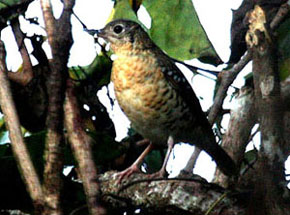 Fawn-breasted Thrush |
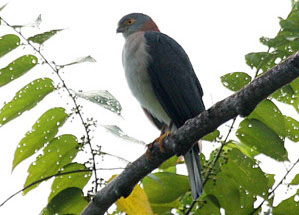 Rufous-necked Sparrowhawk |
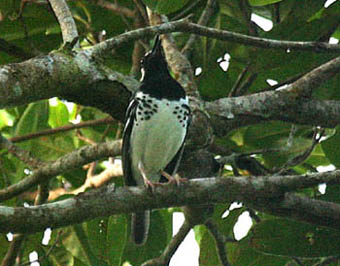 Slaty-backed Thrush |
|
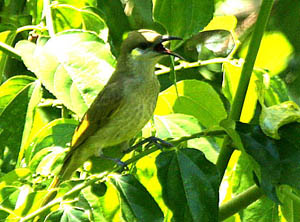 Olive Honeyeater |
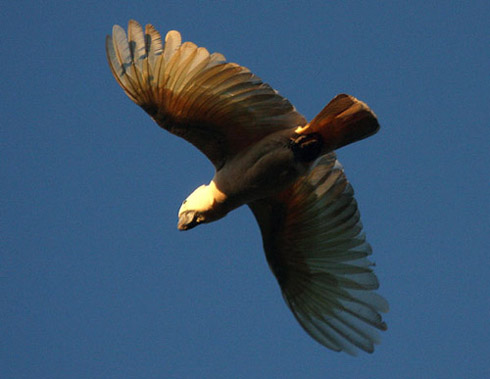 Salmon-crested (Seram) Cockatoo |
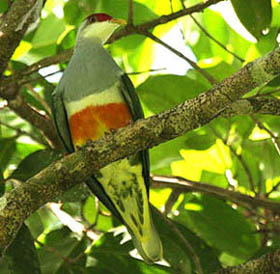 Wallace's Fruit-Dove |
|
We visited Ambon, Yamdena in the Tanimbars, the Kai Islands and Seram. My main interest was in Kai and Seram as I had been to Ambon and the Tanimbars in 2004. It was a good trip as we saw all the specialities realistically possible with our itinerary except for Tanimbar Scrubfowl and Lesser Masked Owl, Rufescent Dark-eye, and Tricoloured Parrotfinch (which I saw on the previous visit to Yamdena). I had 22 Clements ticks plus 4 potential splits. The best sightings for me were on Seram: a Rufous-necked Sparrowhawk calling and displaying, an adult Cinnamon-chested Flycatcher with a juv, a Salmon-crested Cockatoo stripping bark off a branch to feed on grubs and the bizarre Long-crested Mynas.
Logistics
I flew to Jakarta from Singapore on Tiger Airways at the end of my annual PNG tour, visited Muara Angke Reserve the following morning and met MC and NP who arrived from UK in the afternoon. We then flew to Ambon on Lion Air – they have a website but tickets can be bought cheaper in Indonesia. The main hurdle is to get confirmed flights in Maluku as they can’t be bought on the net and schedules are changed frequently. For this we contacted Poli in Jakarta (tel +62 21 837 867 77 and +62 21 837 867 26-28, mobile +62 8192150107 and +62 8125020781, poliecoventure@gmail.com. His friend Ceisar +62 81343227859 on Ambon bought the tickets and booked accommodation, cars and guides on Kai and Seram. Vinno wallaceanmans@yahoo.com, who runs the Masi Hulan Parrot Rehabilitation project near Sawai, guided us on Seram and was very useful. Olaf helped and accompanied us on Kai – useful but not essential – but the Yamdena guide never materialised. We hired ojeks (motor-cycle taxis) on Kai and bemos (minibuses) on Yamdena.
The Ambon – Saumlaki (Tanimbar) – Tual (Kai) – Ambon flights were on Trigana Air. Express Air also fly to Saumlaki 3 days a week and Lion to Tual. I bought my Ambon – Jakarta flight at Ambon airport with Batavia Air, much cheaper than Lion.
Other Notes
It is well worth getting an Indonesian sim card as calls and texts are very cheap, including international. Many people have mobiles and cover is good, although not in North Seram or around Lorulun Farm, Yamdena.
Visas for 30 days can be obtained for US$25 at the arrival airport.
The essential field guide is Coates and Bishop (1997): A Guide to the Birds of Wallacea. Dove Publications, Alderley, Queensland, Australia.
There is surprisingly little information available on birding in this region; the Periplus guide Birding Indonesia by Jepson and Ounsted (1997) has some but is out of date for Seram. There are a few articles in OBC publications, most notably Rheindt and Hutchinson’s on Seram and Buru in BirdingASIA 7 (2007). The only useful trip reports I know of are an old hand-written one by Filip Verbelen, largely out of date now, a BirdQuest report by Mark van Beirs, a KingBird trip report by Ron Hoff, and a Birdtour Asia recce report by Rob Hutchinson.
I am very grateful to Rob Hutchinson and Ding Li, who were very helpful; Bram Demeulemeester, who gave me some tips: John Bowler who wrote me a very detailed account of his birding experiences trekking on Seram years ago when I first planned to go there; and Mike Catsis who’s contribution to the Oriental Birding internet group was very useful and he kindly corrected my errors.
Itinerary
Sun, 19th Jul JH: am Muara Angke, MC and NP arrive Jakarta pm. Sano Hotel, Jakarta
Mon, 20th Jul Fly Jakarta-Ambon (01:30/06:45), bird Tulehu road Baguela Bay Resort
Tue, 21st Jul Fly Ambon-Saumlaki, Yamdena a.m. Pm birding Km 21 Harapan Indah Hotel
Wed, 22nd Jul Lermatang road a.m., pm owling Harapan Indah Hotel
Thu, 23-24 Jul Lorulun Farm Lorulun Farm
Sat, 25th Jul Lorulun Farm Harapan Indah Hotel
Sun, Sun, 26th Jul Lermatang road early am. Fly Saumlaki-Langgur, Tual, Kai. Pm Defur Forest. Suita Indah Hotel
Mon, 27th Jul Ohoililur Resort forest, Kai Kecil Suita Indah Hotel
Tue, 28th Jul Ferry to Kai Besar, pm Dullah, Kai Kecil Suita Indah Hotel
Wed, 29th Jul Fly Langgur-Ambon (0815/0945). Ferry to Amahai, Seram Isabela Hotel, Masohi
Thu, 30 Jul Masohi-Manusela NP Hotel at Sawai
Fri, 31st Jul-1 Aug Seram: Manusela NP Sawai
Sun, 2nd Aug Seram: Manusela NP, drive to Wahai Fitri Hotel, Wahai
Mon, 3rd Aug Manusela NP, Wahai; drive to Sawai, boats to P.Lusaolate and P.Sawai. Sawai
Tue, 4th Aug Drive back to Masohi (Seram), ferry to Ambon: 14:00/15:40 Baguala Bay Hotel
Wed, 5th Aug Jon: Ambon-Jakarta-Singapore-London
Nick and Mike: Ambon-Timor via Surabaya.
Sites
Yamdena, Tanibars
1. We spent most time at Lorulun Farm, with permission from the Harapan Indah Hotel owners – take food, eggs can be bought there. I called this Lorengau farm in my 2004 report, probably in error. It is at about Km 21 on the right of the main road, c.3 km after the turn-off to Lorulun village. The best trails were the one along the stream next to the boundary of the farm, and the one on the right just before the first small bridge after the stream-trail. Most of the specialities were seen along these except for the Scrubfowl, Lesser Masked Owl, Cinnamon-banded Kingfisher, Elegant Pitta and Tricoloured Parrotfinch that were not seen at all, and Pied Bronze-cuckoo and Five-coloured Munia. The Bush-warbler and Slaty-backed Thrush are responsive to play-back but Fawn-breasted Thrush requires some luck or sitting quietly in a likely spot. The latter trail has been blocked by tree-felling after a few 100 m – we could not find it further on, which was where I saw the Parrotfinch in 2004. There is also a trail on the opposite side of the road c.200m before the stream-trail – we “called-out” the cuckoo near the start of this and saw the munia in the adjacent grassland. The younger of the two “farmers” at the farm claimed to know a tree-hole roost for the Tyto a 2 hour walk from the farm but said he could not take us because he was not allowed to leave the farm!
2. We drove to Lermatang from Saumlaki but could not find access to the primary forest here recommended by Ding Li. We explored a patch of logged forest further back along the road, seeing Bush-Warbler, Bronze-cuckoo and our only Bonelli’s Eagle, but no Tyto when we returned before dawn on our last day. We tried Rob Hutchinson’s site for the Tyto, beyond a new army camp along a left turn after the last large village before Lorulun farm. Our vehicle could not pass a muddy patch not long after the army camp so we walked for a few km but nowhere near as far as Rob’s and Ben King’s groups had gone before they saw the owl. It would be best to hire a flat-bed truck or high-clearance 4x4 vehicle for this search.
Kai
1. Ohoililur Resort, Kai Kecil, is 30 mins by ojek from town – we saw Kai Coucal on the way. We walked along the coastal path for c.1km, then took a short inland trail and climbed up to the karst limestone plateau. Here we saw White-tailed Monarch and Little Kai White-eye, with Island Whistler for me, Cinnamon-chested Flycatcher for Mike and Red-bellied Pitta for Nick.
2. We looked for Taman Angrekk (recommended by Filip Verbelen) near Dullah, taking a right turn along a partly tarred road, but could not find it. We tried several logging tracks off this road, the best being a wide one on the left some 5 mins after the turn-off, just after a tall flagged pole. We found a Kai Cicadabird in the secondary forest.
3. The ferry to Kai Besar goes any time between 9 and 10 am, when full. The journey should take an hour but took nearly 2 hours for us as only one engine was working. We were told it would return at 4 pm but it actually left at 2.15 so we missed it and had to charter a speed-boat at considerable expense (1.5 million Rp). We saw Great Kai White-eye in forest patches by taking trails off the road crossing the island, not far from the town.
Seram
The public speed-boat ferry from Ambon goes twice a day to Amahai on the south coast. We caught the afternoon boat with Vinno at 4 pm, reaching Seram at 5.40. We were met by Noke who transferred us in his 4 x 4 to a hotel at Masohi 5-6 km away. Although we spent 4 hours at a birdy logged area 40 mins drive away the following morning, everything we saw occurred on the north coast so there was no real need for this, we could have gone straight on to the trans-island road and spent time on the way up at 600-900m looking for Rufescent Dark-eye. The road passes through Manusela NP, eventually reaching 1150-1200m, where we saw Long-tailed Mt-pigeon (which proved to be thin on the ground) and Seram Honeyeater. The road then contours around 900m asl for some distance before climbing to the pass at 1250m, then drops steeply to the coast, where a left turn takes you past the parrot rehab centre to Sawai where there is a good hotel at the far end of town. The 8 km road to Sawai was very bad in places, but was being upgraded. Most of our birding was spent along the trans-island road, from the pass to the coast, the key areas being
1. The pass, where we had our only Grey-hooded Darkeye. This area is the best place to look for the two endemic Lories but they are unlikely to be seen – see below. It was possible to walk inside the forest c.200m distance below the pass (Sawai side) where there was a simple log bridge crossing the ditch on the left (going down) into open forest. Here we flushed a possible Seram Thrush and saw Cinnamon-chested and Snowy-browed Flycatchers at a tree-fall.
2. At c.800m asl we saw an adult and juv Cinnamon-chested Flycatcher from the road one day, and a calling Rufous-necked Sparrowhawk another day. Despite several sessions at 900-600 m, the optimum elevation according to Coates and Bishop, we did not see Rufescent Dark-eye, and only a few Seram White-eyes in large flocks of Mountain White-eyes. We also looked for the Dark-eye at this elevation on the southern side of the pass without success – perhaps this elevation is not the optimum or the bird is an altitudinal migrant.
3. The remnant forest patches around the junction of the Sawai road were good for lowland birds including the Cockatoo, Long-crested Myna and Pale-grey Cuckoo-shrike.
We took two boat trips to Palau Sawai and nearby P. Radjah, looking for Olive Honeyeater and Forsten’s Scrubfowl, failing to find the former but seeing the latter at the far end of P. Sawai in the late afternoon on our second visit. Palau Lusaolate is the only known site for the honeyeater and is reached by boat from Besi (20 min ride, 70k Rp) or Opin/Odin, both a left turn off the Wahai road some 30 mins drive from the Sawai turn.
We had to travel another 1h 40 mins to Wahai to find Lazuli Kingfisher. We thought we had called in Moluccan Boobook c.12 km further on, just within the National Park, but found it to be Moluccan Scops, thanks to the misidentification of the owl recording we had been given. Both the kingfisher and the owl were heard around Sawai but we could not see them.
The two endemic parrots are almost impossible to see from the road. Purple-naped Lory is very rare due to excessive trapping and stays in the forest canopy, according to Vinno. Blue-eared Lory is said to be common at elevations well above the pass so requires a trek of several days to see as there are no upwards trails off the road.
We wanted to visit Haruku island off Ambon for Molccan Scrubfowl but Ceisar said he had to get his contact to clear it with the locals and he could not get hold of her, so we could not do it. We were quoted 2 million Rp for boat and local help.
Initials in brackets indicate only the one observer saw the bird.
Great and Lesser Frigatebird Fregata minor and F. ariel: A few of each positively identified on the islands but most of the locally numerous frigatebirds, max being 60+ off Kai Kecil on 27th, were unidentified.
Little Black Cormorant Phalacrocorax sulcirostris: A flock of c.20 at Saumlaki, Tanimbars and 1 at Palau Sawai, Seram.
Little Pied Cormorant Phalacrocorax melanoleucos: One at Ohoililur, Kai Kecil and 2 off P. Sawai.
Pied Heron Egretta picata: 6 at Saumlaki airport, Tanimbar.
Great Egret Ardea alba: Two singles on Yamdena, Tanimbar; may have been overlooked elsewhere.
Great-billed Heron Ardea sumatrana: One along Lermatang road near Saumlaki, Tanimbar.
Little Egret Egretta garzetta: Small numbers were noted on Seram’s coast.
Pacific Reef-Heron Egretta sacra: A few on the N Seram coast.
Striated Heron Butorides striatus: The only one seen was at P. Sawai, Seram (moluccarum).
Teal Anas sp. Two Grey Teal or Sunda Teal flew over Lorulun Farm, Tanimbars on 25th (JH). Neither is listed by Coates and Bishop as definitely recorded on Tanimbars.
Australian Ibis Threskiornis molucca: Three on the mudflats at P. Sawai, Seram.
Osprey Pandion haliaetus: One fishing at Sawai, Seram on 31st.
Pacific Baza (Crested Hawk) Aviceda subcristata: One on Ambon and a few reinwardtii on Seram
Brahminy Kite Haliastur indus: One or 2 on most days on Seram but only one on Tanimbar.
White-bellied Sea Eagle Haliaeetus leucogaster: Singles on Yamdena on 3 days, and one on Seram (MC).
Variable Goshawk Accipiter hiogaster: One polionota race on Tanimbar, an albiventris on Kai Kecil, and a single hiogaster on Seram on 3 days.
Rufous-necked Sparrowhawk Accipiter erythrauchen: One of this rarely observed Moluccan endemic called from a perch by the trans-island road on Seram at an altitude of c800m (ceramensis). It was later seen in undulating display flight.
Black Eagle Ictinaetus malayensis: One or 2 daily on Seram
Bonelli’s Eagle Hieraaetus fasciatus: One perched by the Lermatang road, Tanimbar. A recent article suggests it should be in the genus Aquila.
Gurney's Eagle Aquila gurneyi: An immature perched by the trans-island road on Seram at a mid elevation.
Spotted Kestrel (Moluccan K) Falco moluccensis: Singles at Saumlaki airport, Tanimbar and on 3 occasions in Manusela NP, Seram.
Orange-footed Scrubfowl Megapodius reinwardt: One at Ohoililur, Kai Kecil (JH).
Forsten’s Scrubfowl Megapodius forstenii: 3 on P. Sawai and heard near Masohi, Seram.
Australian Pratincole Stiltia Isabella: 3 at Saumlaki airport.
Whimbrel Numenius phaeopus: A few along the northern coast of Seram.
Common Sandpiper Actitis hypoleucos: Only 1, at Saumlaki, Tanimbar.
Common Redshank Tringa tetanus: One near Wahai on 3rd July.
Gull-billed Tern Gelochelidon nilotica: One at Saumlaki on 21st July.
Greater Crested Tern Sterna bergii: One or 2 on Seram.
Spotted Dove Streptopelia chinensis: Small numbers in open habitats on Ambon, Kai and Seram
Brown Cuckoo-Dove (Slender-billed C-D) Macropygia amboinensis: Fairly common in forest on Ambon, Kai and Seram.
Barred-necked Cuckoo-Dove (Dusky C-D) Macropygia magna: Fairly common daily on Tanimbar (timorlaoensis).
Emerald Dove (Green-winged Pigeon) Chalcophaps indica: A few timorensis seen on Kai and Tanimbar but frequently heard calling.
Barred Dove Geopelia maugei: Several on Tanimbar and Kai.
Wallace’s Fruit-Dove Ptilinopus wallacii: Fairly common on Tanimbar.
Superb Fruit-Dove Ptilinopus superbus: Singles on Ambon, and on Seram on 3 days.
Rose-crowned Fruit-Dove Ptilinopus regina: Common on Tanimbar and a few on the Kai Islands. The form here, xanthogaster, does not show any rose in its plumage.
White-bibbed Fruit-Dove Ptilinopus rivoli: A few on Seram and the Kai Islands.
Claret-breasted Fruit-Dove Ptilinopus viridis: One on Ambon and 4 near Wahai on Seram.
Spectacled (White-eyed) Imperial-Pigeon Ducula perspicillata: Common on Seram and 1 on Ambon. Rheindt and Hutchinson recommend splitting this from the Buru form as Seram Imperial-Pigeon Ducula neglecta.
Elegant/Blue-tailed Imperial-Pigeon (Yellow-eyed I-P) Ducula concinna: Fairly common on Tanimbar and Kai.
Pink-headed Imperial-Pigeon Ducula rosacea: Several on Tanimbar. Near Threatened.
Pied Imperial-Pigeon Ducula bicolor: Common on Kai and Seram.
Long-tailed Mountain-Pigeon Gymnophaps mada: Only a few above 1000m on Seram, also recommended by Rheindt and Hutchinson for splitting from the Buru form, as Seram Mountan-Pigeon Gymnophaps stalkeri.
Blue-streaked Lory Eos reticulata: Fairly common around Lorulun Farm and a few in flight elsewhere on Yamdena (Tanimbar).
Moluccan Red Lory Eos bornea: Common on Seram, 6 on Ambon but only one on Kai.
Purple-naped Lory Lorius domicella: One heard at c.1100m below the pass on Seram, identified by Vinno. There were 2 in the rehab centre waiting release and 2 pet birds in a garden in Air Besar village.
Rainbow Lorikeet Trichoglossus haematodus: Common on Seram and a few on Ambon (nominate).
Red-flanked Lorikeet Charmosyna placentis: A few near Wahai, Seram (NP).
Yellow-capped Pygmy-Parrot Micropsitta keiensis: Only heard in flight on Kai Besar.
Salmon-crested Cockatoo (Seram Cockatoo) Cacatua moluccensis: First heard on 31st July and seen at a great distance from a lookout point at 900m on the road; 4 observed feeding at the Sawai/Wahai road junction and 3-4 from the road on the journey back to Amahai, Seram. Vulnerable.
Tanimbar Corella (Tanimbar Cockatoo) Cacatua goffini: Small numbers on Tanimbar, with a max of 12 on 26th. Near-Threatened.
Eclectus Parrot Eclectus roratus: A few seen on Seram but only 1 on Yamdena and only heard on Kai.
Red-cheeked Parrot Geoffroyus geoffroyi: Fairly common on all the islands except Kai where only one was seen.
Great-billed Parrot Tanygnathus megalorhynchos: Only 3 on Tanimbar but fairly common on Seram.
Moluccan King Parrot Alisterus amboinensis: Only two singles seen on Seram, with another 2 heard.
Brush Cuckoo (Rusty-breasted/ Chestnut-breasted C) Cacomantis (sepulcralis/castaneiventris) variolosus: 3 seen on Ambon and one on Seram, heard on Kai and Seram. The taxonomy of this species is highly confusing, eg see what Rheindt and Hutchinson (2007) say in BirdingAsia.
Pied (Little) Bronze-Cuckoo Chrysococcyx (minutillus) crassirostris: One was called in near Lorulun farm on 24th and a pair observed on the Lermatang road, Tanimbar; a pair was photo’d near Defur, Kai Kecil. Split from Little B-C by Coates and Bishop and Birdlife, not by HBW and Clements, but a very distinctive endemic to SE Wallacea, missed on my previous visit.
Asian Koel Eudynamys scolopaceus: Often heard on Ambon and Seram.
Australian Koel Eudynamys cyanocephalus: Heard a few times on Tanimbar.
Channel-billed Cuckoo Scythrops novaehollandiae: Heard most days on Tanimbar and Kai.
Kai Coucal Centropus spilopterus: 2 near Defur, Kai Kecil and one near Ohoililur.
Lesser Coucal Centropus bengalensis: Three singles in open habitats on Seram.
Moluccan Scops-Owl Otus magicus: One was seen after play-back at dawn 12km beyond Wahai, Seram, with others calling there. We heard owls calling at Sawai and on P. Sawai but could not see them. We are unsure of their identity now because there was a mix-up in the identification of the owl recordings I had been given, but I strongly suspect both the Scops and Boobook were present at Sawai.
Moluccan Boobook (Moluccan Hawk-Owl) Ninox squamipila forbesi: One was called in some 25km northwest of Saumlaki, Tanimbar. Rheindt and Hutchinson recommend splitting this sp. into three, the form on Seram and Buru being Hantu Boobook N. squamipila, with Tanimbar Boobook N.forbesi on the Tanimbars.
Large-tailed Nightjar Caprimulgus macrurus: One on Ambon and heard on Seram.
Uniform Swiftlet Aerodramus vanikorensis: Common on Tanimbar, probably overlooked elsewhere.
Moluccan Swiftlet Aerodramus infuscata: Several on Ambon and in Manusela National Park, Seram.
Rheindt and Hutchinson recommend splitting this from the Sulawesi and Halmahera forms as Seram Swiftlet Aerodramus ceramensis.
Glossy (White-bellied) Swiftlet Collocalia esculenta: Fairly common throughout.
Moustached Treeswift Hemiprocne mystacea: 2 near Masohi and 1 near Wahai, Seram.
Lazuli Kingfisher Halcyon lazuli: 3 near Wahai, Seram on Aug 2 and 3.
Collared Kingfisher Halcyon chloris: A few throughout.
Sacred Kingfisher Halcyon sancta: Odd ones on Yamdena and Seram.
Rainbow Bee-eater Merops ornatus: 2 on Kai Besar.
Dollarbird Eurystomus orientalis: Two on Kai Kecil and 1 or 2 on Seram.
Blyth’s Hornbill (Papuan Hornbill) Rhyticeros plicatus: Common on Seram.
Red-bellied (Blue-breasted) Pitta erythrogaster: One at Ohoililur, Kai Kecil (macklotii) (NP).
Pacific Swallow Hirundo tahitica: The common resident hirundine throughout the lowlands.
Tree Martin Petrochelidon nigricans: One hawking around Elat harbour on Kai Besar on 29th July. A rare migrant from Australia.
Wallacean Cuckoo-Shrike Coracina personata: A pair on Tanimbar on 3 days (unimodus) and one pair on Kai (pollens).
Moluccan Cuckoo-Shrike Coracina atriceps: Only two sightings on Seram, of a single and a pair (nominate).
White-bellied Cuckoo-shrike Coracina papuensis: a party of 10 on 23rd at Lorulun, Tanimbar. Uncommon or rare in SE Wallacea (Coates & Bishop).
Kai Cicadabird (Kai Cuckoo-Shrike) Coracina dispar: A female near Taman Anggrek and a male near Dullah, Kai Kecil.
Common Cicadabird Coracina tenuirostris: One photographed near Defur village, Kai Kecil – listed for Seram but not Kai in Coates & Bishop.
Pale Cicadabird (Pale-grey Cuckoo-Shrike) Coracina ceramensis: Two on 29th July in degraded forest on the outskirts of Masohi and 2 near the turn-off to Sawai on 1st August, in the Seram lowlands.
Tanimbar Triller Lalage moesta: Fairly common, with up to 4 most days on Tanimbar. Coates & Bishop and HBW lump this distinctive taxon in Black-browed Triller Lalage atrovirens.
Varied Triller Lalage leucomela: Fairly common on the Kai islands.
Southern Golden Bulbul Thapsinillas affinis: Several on Seram and 1 on Ambon.
Spangled Drongo Dicrurus bracteatus: Common on Seram and one on Ambon.
Wallacean Drongo Dicrurus densus: 2 – 4 daily on the Kai Islands (megalornis) but only 1 or 2 on Yamdena on 25-26th July (kuehni).
Seram Oriole (Grey-collared O) Oriolus forsteni: Fairly common on Seram but not easy to see.
Black-eared Oriole (Buru O) Oriolus bouroensis: Fairly common on Yamdena, Tanimbar. Rheindt and Hutchinson recommend splitting this from the Buru form as Tanimbar Oriole Oriolus decipiens.
Slender-billed Crow Corvus enca violaceus: Three in degraded forest on the outskirts of Masohi, one near the Sawai turn-off and two 8km E of Wahai, Seram. Another species with complex taxonomy, this race violaceus being distinctively small with a barking call, possibly meriting specific status.
Torresian Crow Corvus orru: Only 1 or 2 on 24-26th July on Yamdena, Tanimbar. The form involved is sometimes split off as a separate species Tanimbar Crow Corvus latirostris.
Slaty-backed Thrush Zoothera schistacea: At least 4 seen on one day at Lorulun and singles seen and others heard on at least two other days. Near-Threatened.
Fawn-breasted Thrush Zoothera machiki: One or 2 singles seen on 3 days at Lorulun, a much better performance than on my previous visit! Near-Threatened.
Rufous-sided Gerygone Gerygone dorsalis: A few daily on Tanimbar.
Tanimbar Bush-Warbler Cettia carolinae: Yamdena. One or 2 daily near Lorulun and Lermatang – not difficult once you know the song. Near-Threatened.
Chestnut-backed Bush-Warbler Bradypterus castaneus: Heard a few times in the highland forests of Seram.
Tawny Grassbird Megalurus timoriensis: A few in grassland and scrub on Yamdena, of unknown subspecies as only recently discovered here; looks quite different from New Guinea and Philippine forms.
Mountain Tailorbird Orthotomus cuculatus: The Moluccan form, dumasi, was commonly heard in the higher reaches of Manusela National Park, Seram but only seen briefly a couple of times.
Island Leaf Warbler Phylloscopus poliocephalus: Common in Manusela National Park, Seram (ceramensis). A potential future split.
Island Verditer Flycatcher Eumyias panayensis: Only 2 pairs in the montane forest of Seram,
Snowy-browed Flycatcher Ficedula hyperythra: One male on two occasions when we went inside the forest at c.1200m on Seram (negroides).
Tanimbar / Rufous-chested Flycatcher Ficedula dumetoria riedeli: Three singles at Lorulun. A proposed split.
.
Cinnamon-chested Flycatcher Ficedula buruensis: One near the ground in the karst forest at Ohoililur, Kai Kecil on 27th July (MC) (siebersii); one at a tree-fall inside the forest at c.1200m on Seram (JH) and an adult with attendant juvenile in roadside forest understorey at c.800m on the Sawai side of the pass (ceramensis). A rarely recorded species!
Little Pied Flycatcher Ficedula westermanni: a pair with a bird party at the pass on Seram.
Island Monarch Monarcha cinerascens: Two on Ambon, up to 6 daily on Kai islands and 2 on P. Sawai, Seram.
Loetoe Monarch Monarcha castus: One or 2 daily on Yamdena (Tanimbar).
Black-bibbed Monarch Monarcha mundus: Several on Yamdena (Tanimbar).
Spectacled Monarch Monarcha trivirgatus: A few in the mountains of Manusela National Park, Seram (nigrimentum).
White-tailed Monarch Monarcha leucurus: Several on Kai Kecil, quite shy. Near-Threatened
Slaty Flycatcher (Slaty Monarch) Myiagra galeata: Fairly common on Ambon and Seram (goramensis).
Broad-billed Flycatcher Myiagra ruficollis: A few on Yamdena (fulviventris). Coates & Bishop and HBW state that this distinctive race is probably best treated as a separate species.
Willie Wagtail Rhipidura leucophrys: Fairly common on Ambon and lowland Seram.
Northern Fantail Rhipidura rufiventris: Common on Kai (assimilis) but scarce on Seram (cinerea) where only 2 singles were seen.
Cinnamon-tailed Fantail Rhipidura fuscorufa: Common on Yamdena, even seen in degraded habitat. The classification of Near-Threatened seems unnecessary.
Streak-breasted Fantail (Streaky-breasted F) Rhipidura dedemi: Common on Seram above c.500m, found in all mixed species flocks.
Long-tailed Fantail Rhipidura opistherythra: The scarcest fantail on Yamdena, with only a few singles seen and always inside the forest. Near-Threatened
Arafura Fantail Rhipidura dryas: Fairly common on Yamdena (hamadryas) and Kai (henrici). A recent split from Rufous Fantail Rhipidura rufifrons.
Golden-bellied Flycatcher Microeca hemixantha: Fairly common on Yamdena including 4 at dusk by the roadside well away from forest on a road some 25km northwest of Saumlaki. Near-Threatened
Island Whistler Pachycephala phaionotus: Only one in a bird party at Ohoililur, Kai Kecil (JH).
Grey-headed Whistler Pachycephala griseiceps: 3 at Ohoililur and 1 near Dullah, Kai Besar (rufipennis). This is a recent split from the Australian Grey Whistler P. simplex, not supported by HBW, only occurring on Kai and New Guinea.
Common Golden Whistler (Golden Whistler) Pachycephala pectoralis: Only a few of this variable-looking and widespread species on Tanimbar (fuscoflava) and Seram (macrorhyncha).
Wallacean Whistler Pachycephala arctitorquis: A few most days on Yamdena (Tanimbar). This is a recent split from White-bellied Whistler P. leucogastra.
Drab Whistler Pachycephala griseonota: A few on Seram (nominate).
White-breasted Wood Swallow Artamus leucorhynchus: Small numbers throughout the lowlands of Yamdena and Seram.
Tanimbar Starling Aplonis crassa: Fairly common on Yamdena and observed nesting inside the Lorulun Farm compound in a palm tree. Near-Threatened
Moluccan Starling Aplonis mysolensis: Small numbers on Seram.
Metallic Starling Aplonis metallica: Common on Ambon, Kai and Seram.
Long-crested Myna Basilornis corythaix: Five on 29th July in degraded forest on the outskirts of Masohi ; 3 on 1st August near the Sawai turn off and 3 on the return drive to Masohi on 4th.
Seram Friarbird Philemon subcorniculatus: Common and conspicuous in forest throughout Seram, often in small groups of up to 4 individuals.
Black-faced Friarbird Philemon moluccensis: Fairly common on Yamdena and Kai. Rheindt and Hutchinson recommend splitting this from the Buru form as Tanimbar Friarbird Philemon plumigenis.
Olive Honeyeater Lichmera argentauris: Common on Palau Lusaolate, with at least 30 birds observed on 3rd August, possibly a lot more; very noisy and conspicuous. It was not found on the two islands closer to Sawai called P. Radjah and P. Sawai, where much of the original vegetation has been converted by human activity.
Scaly-breasted Honeyeater (White-tufted H) Lichmera squamata: Very common on Yamdena where found daily, especially in secondary growth but also in the forest interior.
Seram Honeyeater Lichmera monticola: Up to 5 daily at 1100 – 1250m in Manusela National Park.
Drab Honeyeater (Drab /Seram Myzomela) Myzomela blasii: Uncommon but difficult to identify with certainty so probably overlooked: 4 singles on 30th July - 1st Aug on Seram.
Wakolo Myzomela Myzomela wakoloensis elisabethae: Fairly common in roadside forest at the highest levels of the road between 1100-1250m, with up to 10 birds on 30th July. Often lumped in Scarlet Honeyeater M. chloroptera.
Black-breasted Myzomela (Banda M) Myzomela boiei: A few singles at Lorulun farm, Tanimbar (annabellae). A recent split from Scarlet Honeyeater M. chloroptera.
Black Sunbird Leptocoma sericea: Fairly common on Ambon and Seram (aspasioides), and Kai
(chlorolaema).
Olive-backed Sunbird (Yellow-bellied S) Cinnyris jugularis: Locally common on Kai (keiensis) and Seram (clementiae). These all belong to the very different looking black-bellied group, which may best be split as a separate species.
Ashy Flowerpecker Dicaeum vulneratum: Very common on Ambon and Seram at any elevation.
Mistletoebird Dicaeum hirundinaceum: Several daily on Tanimbar (fulgidum) and Kai (keiense). Looks very different from the well-known Australian species.
Mountain White-eye Zosterops montanus: Common in noisy, fast moving flocks in the higher reaches of Manusela National Park, Seram (obstinatus).
Ashy-bellied White-eye Zosterops citrinellus: Fairly common on Tanimbar (albiventris).
Great Kai White-eye Zosterops grayi: 6 in forest patches by the main road going left from the port of Elat inland and upwards on Kai Besar (Great Kai) where it is endemic. HBW and BirdLife have changed its name to Pearl-bellied White-eye. Near-Threatened.
Little Kai White-eye Zosterops uropygialis: Fairly common, usually in pairs, in secondary forest patches on Kai Kecil (Little Kai). HBW and BirdLife have changed its name to Golden-bellied White-eye. Near-Threatened.
Seram White-eye Zosterops stalkeri: Single pairs seen on 3 days in mixed flocks dominated by Mountain White-eyes in Manusela National Park up to 900m. It used to be lumped in Black-fronted White-eye Zosterops atrifrons of New Guinea.
Ambon White-eye Zosterops kuehni: Two pairs in a forest patches along the road to Tulehu village on Ambon. Near-Threatened.
Grey-hooded White-eye Lophozosterops pinaiae: One only was found in a mixed flock at the pass in Manusela National Park. It was silent and inconspicuous, probing branches in a nuthatch–like manner.
Eurasian Tree Sparrow Passer montanus: Present in most built-up areas.
Black-faced Munia (Moluccan M) Lonchura molucca: A few on Kai but only 2 noted on Seram, at Masohi.
Scaly-breasted (Nutmeg M) Munia Lonchura punctulata: A few parties on Tanimbar.
Chestnut Munia Lonchura malacca: A few at Masohi, Seram – not listed for Seram, so probably a range extension from the Ambon population which was thought to have been introduced from Sulawesi.
Five-coloured Munia Lonchura quinticolor: 2 – 6 on 3 days around Lorulun farm, Tanimbar.
Muara Angke, Jakarta list - 19 July 2009
Little Black Cormorant Phalacrocorax sulcirostris: common flying over.
Oriental Darter Anhinga melanogaster: A few.
Grey Heron Ardea cinerea: A few.
Purple Heron Ardea purpurea: A few.
Striated Heron Butorides striatus. 2.
Javan Pond-Heron Ardeola speciosa: A few.
Black-crowned Night-Heron Nycticorax nycticorax: Several.
Black Bittern Dupetor flavicollis: One in flight.
Sunda Teal Anas gibberifrons: 2.
Ruddy-breasted Crake Porzana fusca: 2.
White-breasted Waterhen Amaurornis phoenicurus: Common.
Common Moorhen Gallinula chloropus. A few.
Black-backed/Purple Swamphen Porphyrio indicus: A few.
Pink-necked Green-Pigeon Treron vernans: A few.
Spotted Dove Streptopelia chinensis: A few.
Plaintive Cuckoo Cacomantis merulinus: 1 chased by a small passerine.
Sunda Coucal Centropus nigrorufus: 1 perched and calling (deep chuckle), 2 in flight then 1 in flight.
Cave Swiftlet (Linchi Swiftlet) Collocalia linchi
Small Blue Kingfisher Alcedo coerulescens: 2.
Sunda Woodpecker Picoides moluccensis: A few.
Fulvous-breasted Woodpecker Denrocopus macei: 2.
Pacific Swallow Hirundo tahitica: Common
Common Iora Aegithina tiphia: A few.
Sooty-headed Bulbul Pycnonotus aurigaster: A few.
Yellow-vented Bulbul Pycnonotus goiavier: Common.
Small Minivet Pericrocotus cinnamomeus: A few.
Grey Tit Parus cinereus: A few.
Golden-bellied Gerygone Gerygone sulphurea: Several.
Clamorous Reed Warbler Acrocephalus stentoreus: Fairly common.
Ashy Tailorbird Orthotomus ruficeps: Fairly common
Bar-winged Prinia Prinia familiaris. Common
Pied Fantail Rhipidura javanica; A few.
White-breasted Wood-Swallow Artamus leucorhynchus: A few.
Javan Myna Acridotheres javanicus. Several.
Scarlet-headed Flowerpecker Dicaeum trochileum. 2.
Javan Munia Lonchura leucogastroides. Several.
Mammals
Long-tailed Macaque (Crab-eating Macaque) Macaca fascicularis: At least 30.